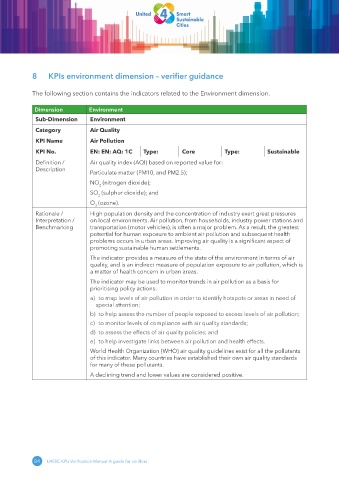Page 94 - U4SSC KPIs Verification Manual - A guide for verifiers
P. 94
8 KPIs environment dimension – verifier guidance
The following section contains the indicators related to the Environment dimension.
Dimension Environment
Sub-Dimension Environment
Category Air Quality
KPI Name Air Pollution
KPI No. EN: EN: AQ: 1C Type: Core Type: Sustainable
Definition / Air quality index (AQI) based on reported value for:
Description
Particulate matter (PM10, and PM2.5);
NO (nitrogen dioxide);
2
SO (sulphur dioxide); and
2
O (ozone).
3
Rationale / High population density and the concentration of industry exert great pressures
Interpretation / on local environments. Air pollution, from households, industry power stations and
Benchmarking transportation (motor vehicles), is often a major problem. As a result, the greatest
potential for human exposure to ambient air pollution and subsequent health
problems occurs in urban areas. Improving air quality is a significant aspect of
promoting sustainable human settlements.
The indicator provides a measure of the state of the environment in terms of air
quality, and is an indirect measure of population exposure to air pollution, which is
a matter of health concern in urban areas.
The indicator may be used to monitor trends in air pollution as a basis for
prioritising policy actions:
a) to map levels of air pollution in order to identify hotspots or areas in need of
special attention;
b) to help assess the number of people exposed to excess levels of air pollution;
c) to monitor levels of compliance with air quality standards;
d) to assess the effects of air quality policies; and
e) to help investigate links between air pollution and health effects.
World Health Organization (WHO) air quality guidelines exist for all the pollutants
of this indicator. Many countries have established their own air quality standards
for many of these pollutants.
A declining trend and lower values are considered positive.
84 U4SSC KPIs Verification Manual-A guide for verifiers

